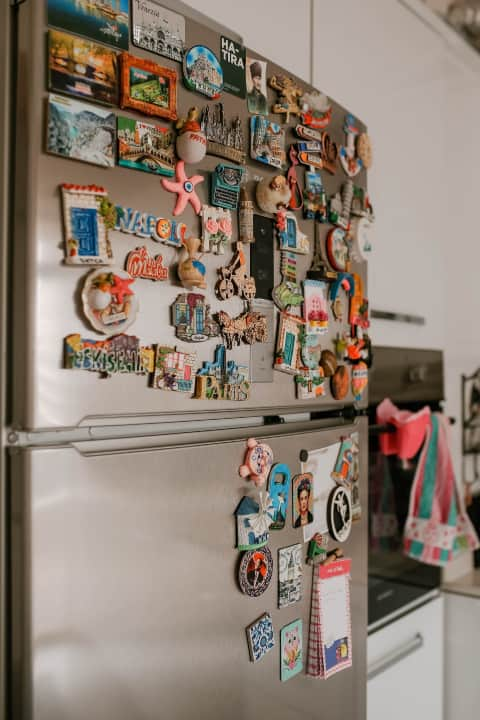



What we love about travel, besides the experience, is that it must come to an end some time. It is an uplifting kind of loss.
When we leave a place, the physical experience of being there, seeing its sights and sounds ends, and we replace the sensorial with memory. Then the only physical thing we have left are the media on our devices and what we buy or acquire during the trip.
In the case of most Indians, it’s the souvenirs—like the ever-popular fridge magnet or snow globe.

The fridge magnet is often mass-produced, and hardly authentic. The largest fridge magnet market for the whole world is China, like Charles Zhao’s multi-million-dollar company Talmud. Most Eiffel Tower miniatures, if plastic, will likely have the ‘Made in China’ tag at the bottom.
What refrigerator magnets do best is make a boring, mass-produced miniature with a magnet attached to it at the back seem more individualized than it otherwise would be. They give us a chance to fill one of the largest blanks in our homes and kitchens other than our walls, with whatever we decide defines us at any particular moment.
Most Indian tourists are fussy, insular travellers whose destinations are as much for gloating as for memory and seeking the best possible Indian food wherever they go. Our fridge doors, busy with the declaration of travel to ‘Paree’ or the Andes, Kovalam or Tawang, declare to the world that we are rich in our travel experiences. They start conversations and facilitate one-sided narrations of how we saw this and that, rode and sailed this or that. For travellers who love to brag, souvenirs like the fridge magnet are our veritable gloat points besides a way of, of course, reliving the physical joy of being at a place.
Today, there’s a lot of snobbery in the travel world. Like everything else, travellers have the pressure to travel for authentic pleasure. You might be a broke backpacker or a budget traveller, but if you travel just for the authentic, immersive experience of the local, to be part of local feasts and hootenannies, you are rich. If you have a lot of money and you still travel with one T-shirt and a backpack, boy, are you rich!
At a time when Marie Kondo, the pundit of purge, is a Netflix as well as a publishing star (the 2014 bestseller The Life-Changing Magic of Tidying Up: The Japanese Art of Decluttering and Organizing, and the 2019 Netflix series Tidying Up with Marie Kondo), cluttering is a sign of dysfunctionality. And to stay ahead of the curve in this world, you better cure your dysfunctionality. But sorry, Marie, we like our fridges cluttered. Because we love to talk about our touristy selves as much—or more than—we love the actual travel.
‘Souvenir’ is a French word that means to remember, and fridge magnets are the most convenient of travel memorabilia. They are, what Autolycus said in The Winter’s Tale, “a snapper-up of unconsidered trifles”. Trifles, they are not, as any middle-class Indian tourist would tell you.
Incidentally, India is the only lower-middle-income country in the top 35 in the Travel and Tourism Competitiveness Index (TTCI) released by the World Economic Forum in 2021. Souvenirs like fridge magnets are treasured indices of our evolved, well-travelled selves. The miniature Eiffel Tower, even with the well-hidden ‘Made in China’ tag, signifies that we have seen the tower, and therefore our life has meaning. They are supposed to be transcendental attachments to the places we have visited.
 (Photo by Gabriella Clare via Unsplash)
(Photo by Gabriella Clare via Unsplash)Among millennials and post-millennials, increasingly, souvenirs are food. Food is becoming a locus of authenticity, because the selfie takes care of the memories. Big blocks of Parmesan from Italy, or chocolates from a rural chocolaterie in Belgium, or the humble homemade feni from that homestay by a river in a Goan village. Or anything handmade by local artisans.
In his book Snoop: What Your Stuff Says About You, Sam Gosling, a professor of psychology at the University of Texas, Austin, examines how our belongings reveal our inner lives. Gosling explains in the book how keepsakes and travel mementoes are deliberate statements of goals, values and what’s important to us—in other words, they say who we are at a given time.
The new traveller, the traveller who optimises Instagram for their one-way gloat points, would make a big deal out of found objects such as pebbles picked from a beach or a spice from a Moroccan lover’s home. The tourist in search of the authentic will most likely baulk at the key ring or the novelty T-shirt that screams New York in red letters. But the classic tourist, the one who knows he is just a tourist, would happily take the miniature bought for a few bucks on a city street straight to their fridge doors.
I like my fridge door empty and spotless. But I did take out some miniatures and posters collected over the years from my travels during the most oppressive, insulated years of our lives: 2021. I held them and felt transported to a ride along the Florida coastline and a monastery in the Eastern Himalayas. I felt hopeful, and looked forward to a time when we would be tourists again. Souvenirs serve their purpose well if we want them to. If only we are willing to travel past the brag.
Discover the latest Business News, Sensex, and Nifty updates. Obtain Personal Finance insights, tax queries, and expert opinions on Moneycontrol or download the Moneycontrol App to stay updated!
Find the best of Al News in one place, specially curated for you every weekend.
Stay on top of the latest tech trends and biggest startup news.